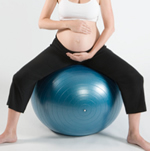 If you’re trying to stay in the fitness habit during your pregnancy, a well-chosen fitness routine that you can do in the comfort of your own home can make it much easier to keep your new commitments.
It can also come in handy after you’ve had your baby, when it’s not as easy to go for a fitness walk or to an exercise class with your baby in tow. You should try to formalize a great routine now and also use it after baby is born.
If you’re trying to stay in the fitness habit during your pregnancy, a well-chosen fitness routine that you can do in the comfort of your own home can make it much easier to keep your new commitments.
It can also come in handy after you’ve had your baby, when it’s not as easy to go for a fitness walk or to an exercise class with your baby in tow. You should try to formalize a great routine now and also use it after baby is born.
Getting a home workout routine started
Firstly, find a good spot in your house that may inspire you to work out whenever you have some free time. Maybe some place near the TV so you can catch up on your favorite shows and workout at the same time. You might also want to opt for an exercise video or even some home equipment like a treadmill or elliptical trainer. Although the latter can be a serious investment, the cost is often no more than that of a one-year gym membership, a swim card for the local pool, or a year’s worth of drop-in aerobic classes. Plus, you won’t have a built-in excuse not to exercise when the weather is bad or you can’t find a baby sitter. Make sure that you keep plenty of water close by and keep your house relatively cool while you are working out. If you should feel faint or dizzy at any time, stop immediately and grab some water. Also make sure you have plenty of room to stretch and cool down afterwards. Flexibility and keeping your heart rate at a relatively low level are both very important.Home exercises during your pregnancy
- Stretching Exercises
Stretching makes the muscles limber and warm. Here are some simple stretches you can perform before and after exercising.
- Neck rotation: Relax your neck and shoulders. Drop your head forward. Slowly rotate your head to your right shoulder, back to the middle and over the left shoulder. Complete four, slow rotations in each direction.
- Shoulder rotation: Bring your shoulders forward and then rotate them up toward your ears and then back down. Do four rotations in each direction.
- Swim: Place your arms at your sides. Bring your right arm up and extend your body forward and twist to the side, as if swimming the crawl stroke. Follow with the left arm. Do the sequence ten times.
- Thigh shift: Stand with one foot about two feet in front of the other, toes pointed in the same direction. Lean forward, supporting your weight on the forward thigh. Change sides and repeat. Do four on each side.
- Leg shake: Sit with your legs and feet extended. Move the legs up and down in a gentle shaking motion.
- Ankle rotation: Sit with your legs extended and keep your toes relaxed. Rotate your feet, making large circles. Use your whole foot and ankle. Rotate four times on each side.
- Tailor Exercises
Tailor exercises strengthen the pelvic, hip and thigh muscles and can help relieve low back pain.
- Tailor sit: Sit on the floor with your knees bent and ankles crossed. Lean slightly forward and keep your back straight but relaxed. Use this position whenever possible throughout the day.
- Tailor press: Sit on the floor with your knees bent and the bottoms of your feet together. Grasp your ankles and pull your feet gently toward your body. Place your hands under your knees. Inhale. While pressing your knees down against your hands, press your hands up against your knees (counter-pressure). Hold for a count of five.
- Kegel Exercise Kegel exercises help strengthen the muscles that support the bladder, uterus and bowels. By strengthening these muscles during your pregnancy you can develop the ability to relax and control the muscles in preparation for labor and birth. Kegel exercises are also highly recommended during the postpartum period to promote the healing of perineal tissues, increase the strength of the pelvic floor muscles and help these muscles return to a healthy state, including increased urinary control.To do Kegels, imagine you are trying to stop the flow of urine or trying not to pass gas. When you do this, you are contracting the muscles of the pelvic floor and are practicing Kegel exercises. While doing Kegel exercises, try not to move your leg, buttock or abdominal muscles. In fact, no one should be able to tell that you are doing Kegel exercises. (So you can do them anywhere!)Kegel exercises should be done every day. We recommend doing five sets of Kegel exercises a day. Each time you contract the muscles of the pelvic floor, hold for a slow count of five and then relax. Repeat this ten times for one set of Kegels.
 Related Video
In our pregnancy video section we have a whole range of videos for you to watch which cover a whole range of subjects, from general pregnancy, complications, newborn care and even beauty.
We have a video which related to fitness and exercise – so be sure to check it out in the video section here
Related Video
In our pregnancy video section we have a whole range of videos for you to watch which cover a whole range of subjects, from general pregnancy, complications, newborn care and even beauty.
We have a video which related to fitness and exercise – so be sure to check it out in the video section hereHome Pregnancy Workout



